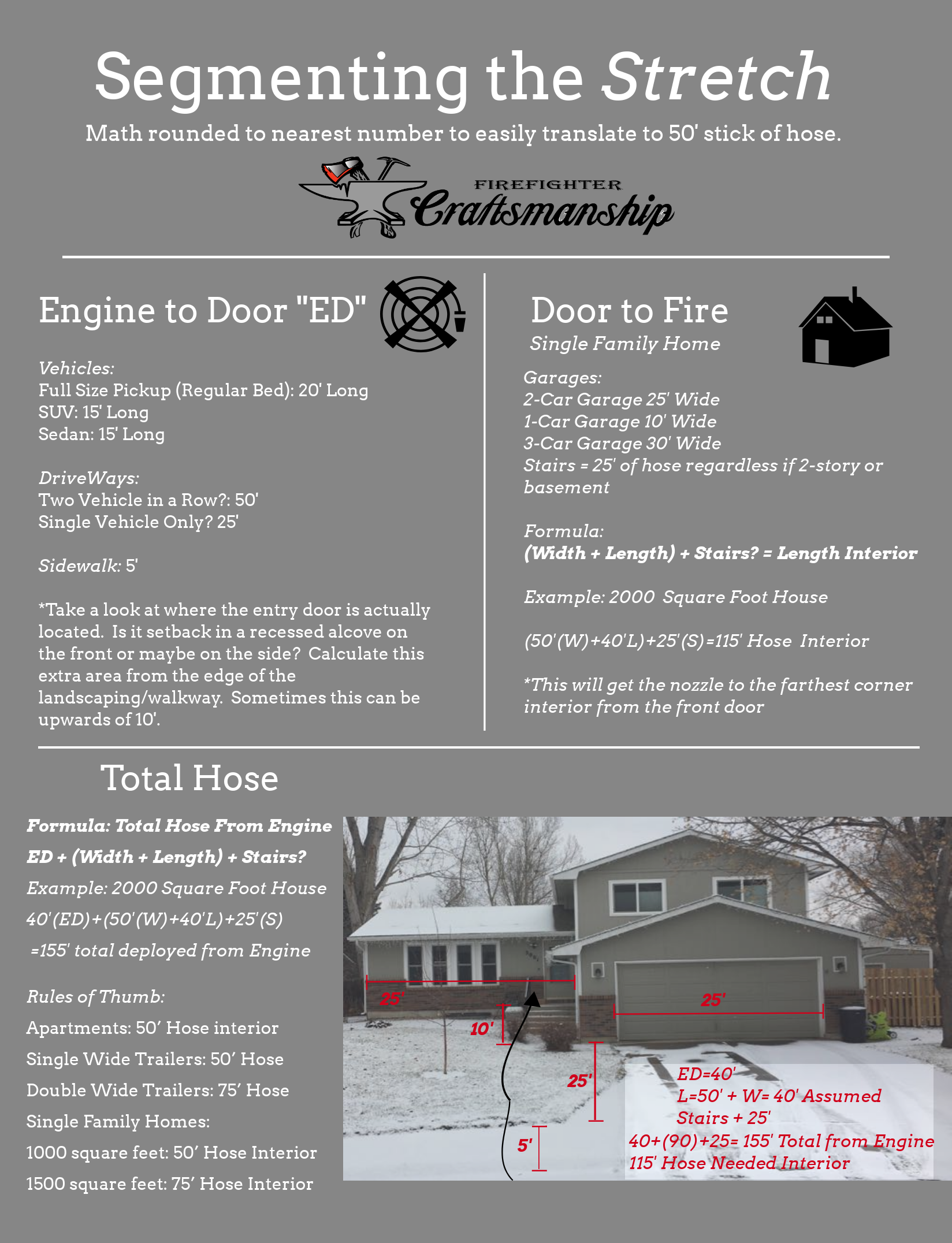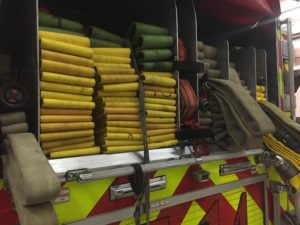
Estimating the Hose Stretch: Suburban Residential Structure Fires
Capt. Kevin Housley Firefighter Craftsmanship 2018
When I went through the fire academy in 2005 we were never taught a simple rule of thumb on how to estimate how much hose we actually needed to efficiently attack a residential or commercial structure fire. It was more along the lines of “know your district” and pretty much on every evolution we attempted to bring the entire pre-connect and the engine itself in the front door of the burn house! All the hose that was truly needed in most of the burn houses we were exposed to was 50’ to 100’.
Currently our staffing model at my department is that we run a crew of 3 on the engine. This, as many of you know, is typical for a lot of suburban departments across the country. The expectation of the nozzle firefighter on our company is that it is his/her responsibility to know how much hose we need, deploy it as quickly as possible, bleed the line so the Driver/Operator (D/O) can appropriately set their pressure and be masked up working on forcible entry issues by the time the officers’ 360 is complete. Then as the officer it is my responsibility to support the hose length decision and bring enough hose into the front door and move it to successfully support the nozzleman fighting the fire. We talk about this a lot as a crew and capitalize on in-area training by stretching on real buildings in our first and second due, on automatic commercial and residential fire alarms, and yes even after EMS runs. The more time the D/O and the nozzle firefighter can work on their estimations the better. It pays off at 0300 with two feet of snow on a real job.
Every hose stretch has multiple facets incorporated into it when attempting to calculate the necessary hose for the fastest and smoothest deployment possible. (We won’t discuss line and nozzle selection here as this will be solely estimating the stretch tactics.) “Segmenting the Stretch” as Battalion Chief Ben Ojinaga of the Greeley Fire Department and founder of “Lead Stretch Advance” calls it is a solid way for the nozzle firefighter and driver to estimate the necessary hose and ensure that you don’t come up short. There are three parts to “Segmenting the Stretch”.
- Engine to Door
- Door to Fire
- Fire Area & Overhaul
This can then be applied to the Aaron Fields and Nozzle Forward methodology of the different starting points for fire attack:
- From the Engine
- From an Appliance
- From a Standpipe
By focusing heavily on segmenting the stretch and determining the best starting point for fire attack we can be better customer servants, more efficient on the fireground and smarter firefighters overall. This allows us to mentally slow down to assist with processing the problem at hand while implementing basic skills at a very high level.
Segmenting the Stretch
- “Engine to Door”
- “Door to Fire”
- Fire Area & Overhaul
Engine to Door:
Get really good at your first due area. Residential subdivisions will be setup in very consistent and predictable ways which maximizes how many homes the developer can jam onto that piece of land. Although many subdivisions are laid out consistently within the neighborhood themselves, they very well could be unique when compared to another neighborhood especially if they were developed in different time periods. Single car garage ranches built in the 50’s and 60’s are dramatically different then the 2-story 3 car garage homes built in 2018. By knowing your area you are able to create some generalizations of entire neighborhoods while enroute and then can adapt based on what you actually find on arrival.
Based on your apparatus setup this is going to be unique for each fire department but understanding and being on the same page with you crew and especially the driver is paramount.
- Do your hoseloads come off as a crosslay or are they deployed off the tailboard?
- Where is the driver going to spot for deployment but also to leave the front of the building for the truck?
- Pull slightly past for viewing 3 sides or right up front?
- Officers, consider having the driver spot like this on every fire and automatic alarm call and almost every EMS call if realistic (blocking and scene management taken into consideration)
- How much hose do we need simply to get to the front door and what’s the best and fastest way to get it there?
- Change the term “Engine to Door” to “Standpipe to Fire Apartment” or “Appliance to Fire” and the same basics of estimating the stretch will apply
Engine to Door Rule of Thumbs:
Estimating distances for me has been a consistent work in progress. Along the way I’ve come up with a few tricks to help. One of the easiest ways I use on single family residential calls is to imagine a 50’ stick of hose rolling out. How far does that coupling end up? I also pick fixed objects that can help me spatially figure out how far it really is to the door from the engine which I also use to estimate how much hose we will need interior in the worst case scenario. Knowing your first and second due neighborhoods is very important here. Are driveways in the response area long enough to accommodate two cars parked in a row? Is the setback of the house very small and the parking for the residence happens off an alley in the back? Is the setback of the home very long and circular or long driveways are common in the subdivision?
Distance Cues
Driveways:
A Full Size Regular bed Pickup is roughly 20’ long
4-Door Sedan/ smaller SUV is 15’ Long
Single Car Driveways are 25’ Long
Driveways where 2-cars can park in a row are 50’
Sidewalks:
Sidewalks in a subdivision are typically 4’ wide (I round this up to 5’ for easier math)
Garages:
2-Car Garages are typically 20’ wide I round them up to 25’ to easily match hoseload math.
1-Car Garages are 10’ Wide
Combine a 2-Car and a 1-Car Garage and make it an even 30’ as a rule of thumb
I use garages as a frame of reference as to how wide the structure is overall. If the front of the house looks like it would accommodate (2) 2-Car Garages set next to one another I know that is 50’ of hose.
The more you practice how much hose you use just to get to the entry door, the easier it will be to instantly identify when a 300’ or 400’ attack line is going to be necessary right away based on setback alone.
Door to Fire:
It is up to the officer to determine the fire location if it isn’t obvious on arrival. The 360 should be conducted in a smooth and fast method assessing all the factors presented on each call including which entry point will provide the engine company the best tactical advantage for an interior attack. As the nozzle firefighter you have to assume that you have a deep seated fire and potentially on upper or lower floors until proven otherwise. Start big picture and think how much hose needs to enter the front door for the farthest possible stretch interior and decrease from there. This covers you on Door to Fire as well as Fire Area & Overhaul in one simple step. The method that works the best for me is to take a residential structures Width + Length. Add 25’ for stairs regardless if they are headed up or down.
Door to Fire Formula:
(Width + Length) + 25’ for Stairs
Ex: (50’+ 40’) +25’= 115’ Hose interior for the farthest corner from the front door
Total Hose:
The total hose calculation is handy when you aren’t sure that the 200’ preconnect will get the job done. Long setbacks from the engine location, large homes, and multifamily residentials present this challenge consistently. By practicing the steps of “Engine to Door” and “Door to Fire” on multiple calls and during training the estimation becomes a whole lot easier. This then translates very well to 3” to a wye/reducer and extended attack lines 300-400’ of 1 ¾” or 2 ½”. More information on ways to accomplish extended hoseline attacks will be featured on https://firefightercraftsmanship.com in the near future.
Determining the total hose needed on the fireground is just a combination of all the steps we have covered in this training article.
The Total Hose Formula is simply:
Engine to Door + (Width + Length) + 25’ for Stairs
Ex: 40’ (ED) + (50’W+ 40’L) +25’= 155’ Total Hose from Engine
Other Rules of Thumb:
Apartments: 50’ Hose interior
Single Wide Trailers: 50’ Hose Interior
Double Wide Trailers: 75’ Hose Interior
Single Family Homes:
1000 square feet: 50’ Hose Interior
1500 square feet: 75’ Hose Interior
Estimating the stretch is a skill that can shave minutes off of a hose deployment on the fireground. Consistent practice and diligence in varying conditions will create a solid habit of knowing exactly how much hose is needed when you arrive on scene. Knowing your first and second due areas and knowing the trends within each subdivision in these areas will pay huge dividends when the fire call comes in. The more you practice and teach these rules of thumb the more ingrained they become into your basic firefighting skill arsenal. Honor Thy Craft.
A special thank you to BC Ojinaga and Lead Stretch Advance for the hose rules of thumb in this article. Check out his work here and on Facebook










Joseph
Love it
ffcraftsman
Thanks Joseph. Hope it’s a useful tool for you.
Nick Marcheso
Very Well done Khou
ffcraftsman
Thanks Queso!